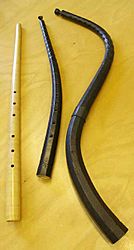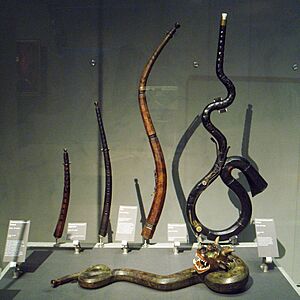Cornett facts for kids

Mute cornett, curved cornett and tenor cornett
|
|
| Other names | Zink, Cornetto, Cornetto curvo |
|---|---|
| Classification | Brass |
The cornett, also known as the cornetto or zink, is an old wind instrument. It was popular from about 1500 to 1650. This instrument was used during the Medieval, Renaissance, and Baroque periods. People often played it in groups called alta capellas, which were like early wind bands. It is important not to confuse the cornett with the modern cornet, which is a type of trumpet.
The cornett makes sound when a player's lips vibrate against a small cup-shaped mouthpiece. The instrument itself is a long, cone-shaped wooden tube, usually covered in leather. It is about 24 inches (60 cm) long. It has finger holes, like a recorder, and a small mouthpiece made of horn or ivory.
Contents
How Cornetts Are Made
Most cornetts, especially the common treble cornett, are made from wood. A piece of wood is carefully split in half lengthwise. Then, each half is hollowed out to create the gently curved, cone-shaped inside of the instrument.
After shaping, the two halves are glued back together. The outside is then smoothed into an eight-sided shape. Finally, the entire instrument is wrapped in thin, black leather. It has six finger holes on the front and one thumb hole on the back, similar to a recorder. These holes are slightly angled. The end where the mouthpiece fits is strengthened with a brass ring. This ring is often hidden by a fancy silver or brass decoration. The mouthpiece itself is a separate piece, usually made from horn, ivory, or bone. It has a thin edge for the lips and a part wrapped in thread to help it fit snugly.
Playing the Cornett
Many musicians agree that the cornett is a challenging instrument to play. It needs a lot of practice to make good sounds. Its design is similar to the Vladimir horn or rozhok, a Russian instrument still played today.
The main part of the cornett is about the same length as a woodwind instrument. However, its mouthpiece is like those used on brass instruments. To change the musical sound, players use a mix of their lips and by opening or closing the finger holes. This changes the length of the air column inside the instrument. Most modern brass instruments are much longer than the cornett. This allows them to use different harmonics (natural notes produced by the instrument). Modern brass instruments also use slides or valves to change their pitch.
During the Baroque era, people liked bright and strong sounds in music. Old pipe organs from that time show this. A writer named Marin Mersenne once said the cornett's sound was like "a ray of sunshine piercing the shadows." This shows how special its sound was considered.
The Cornett in Modern Music
Thanks to a recent movement called historically informed performance, the cornett has become popular again. This movement tries to play old music exactly as it would have sounded long ago. Because of this, talented musicians are learning to play the cornett once more.
In the past, the violin was often used instead of the cornett in music. Today, other instruments can also take its place in modern performances. These include the recorder, the modern B-flat trumpet, the oboe, and the soprano saxophone.
Images for kids
See also
 In Spanish: Cornetto para niños
In Spanish: Cornetto para niños




